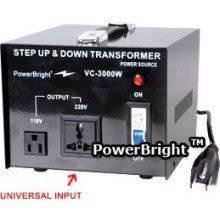Hey, Fellow Conqueror Owners.
For the past three years, we were challenged with the electronic panel in our Conquest.
We never could get the battery charger to charge the battery.
Then there would be times when the Shore power would work, and sometimes it would show AC on, but the indicator would be dim, and the sometimes it wouldn't work at all.
As some of you know, I just sold the Conquest and purchased a Conqueror Commander. Low and behold, it has a step up transformer included in the unit.
Turns out, the charge panels are set up strictly for 220 EURO (not 220 US) current. Apparently the units we all purchased out of Atlanta, they tried to wire them up to accept 110, but all the components don't work (i.e. the battery charger). This is probably why so many of you suffered "fan loss" in your units.
The step up transformer works like this: Shore power (US 110) connected to the outside of the trailer. Then the line inside the trailer from inside the shore power plugs into this aftermarket 3000 watt step up/step down transformer. There is a Euro 220 plug on the "out" on front of the transformer. There is a Euro Plug that plugs into that front "out" and from there runs to the Conqueror Power Unit.
Here is a picture of the transformer:

Of note: I had to figure this out on my own, as the first owners of the Conqueror were not involved in the hand off of the trailer to me. When I first got it, it had 110 running straight to the Conqueror Power Box. It would show the charger being on, but it was not charging. It would show that I had shore power, but the indicator lights on the power box were dim.
Once I determined this method outlined above, the entire system now works like a charm. The couple that had the trailer just had the transformer sitting on the floor. It is a 37 Pound brick, and you could easily break a toe on it. I plan to find a permanent place for it to be stored while being used that allows it to be strapped down.
Hope this makes some sense and is not too confusing. It just really opened my eyes to answers for the challenges some of us Conqueror owners have bounced e-mails around about.
Thanks
Dendy
For the past three years, we were challenged with the electronic panel in our Conquest.
We never could get the battery charger to charge the battery.
Then there would be times when the Shore power would work, and sometimes it would show AC on, but the indicator would be dim, and the sometimes it wouldn't work at all.
As some of you know, I just sold the Conquest and purchased a Conqueror Commander. Low and behold, it has a step up transformer included in the unit.
Turns out, the charge panels are set up strictly for 220 EURO (not 220 US) current. Apparently the units we all purchased out of Atlanta, they tried to wire them up to accept 110, but all the components don't work (i.e. the battery charger). This is probably why so many of you suffered "fan loss" in your units.
The step up transformer works like this: Shore power (US 110) connected to the outside of the trailer. Then the line inside the trailer from inside the shore power plugs into this aftermarket 3000 watt step up/step down transformer. There is a Euro 220 plug on the "out" on front of the transformer. There is a Euro Plug that plugs into that front "out" and from there runs to the Conqueror Power Unit.
Here is a picture of the transformer:

Of note: I had to figure this out on my own, as the first owners of the Conqueror were not involved in the hand off of the trailer to me. When I first got it, it had 110 running straight to the Conqueror Power Box. It would show the charger being on, but it was not charging. It would show that I had shore power, but the indicator lights on the power box were dim.
Once I determined this method outlined above, the entire system now works like a charm. The couple that had the trailer just had the transformer sitting on the floor. It is a 37 Pound brick, and you could easily break a toe on it. I plan to find a permanent place for it to be stored while being used that allows it to be strapped down.
Hope this makes some sense and is not too confusing. It just really opened my eyes to answers for the challenges some of us Conqueror owners have bounced e-mails around about.
Thanks
Dendy
Last edited:

